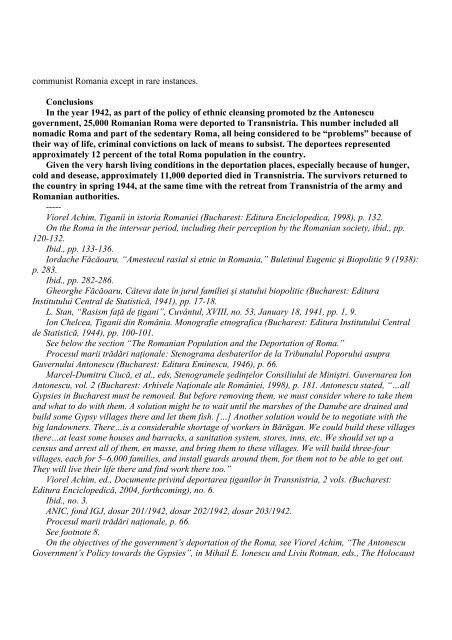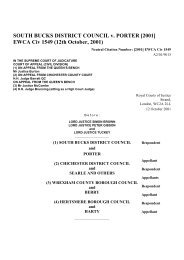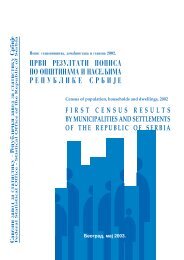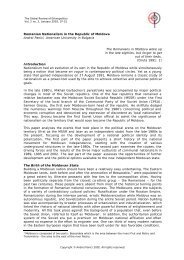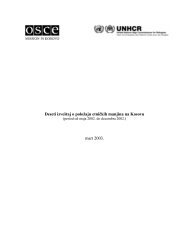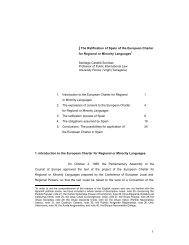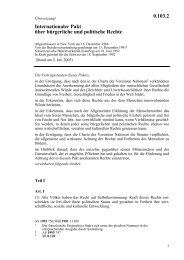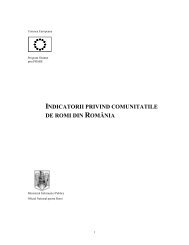Final Report of the International Commission on the - Minority Rights ...
Final Report of the International Commission on the - Minority Rights ...
Final Report of the International Commission on the - Minority Rights ...
You also want an ePaper? Increase the reach of your titles
YUMPU automatically turns print PDFs into web optimized ePapers that Google loves.
communist Romania except in rare instances.<br />
C<strong>on</strong>clusi<strong>on</strong>s<br />
In <str<strong>on</strong>g>the</str<strong>on</strong>g> year 1942, as part <str<strong>on</strong>g>of</str<strong>on</strong>g> <str<strong>on</strong>g>the</str<strong>on</strong>g> policy <str<strong>on</strong>g>of</str<strong>on</strong>g> ethnic cleansing promoted bz <str<strong>on</strong>g>the</str<strong>on</strong>g> Ant<strong>on</strong>escu<br />
government, 25,000 Romanian Roma were deported to Transnistria. This number included all<br />
nomadic Roma and part <str<strong>on</strong>g>of</str<strong>on</strong>g> <str<strong>on</strong>g>the</str<strong>on</strong>g> sedentary Roma, all being c<strong>on</strong>sidered to be “problems” because <str<strong>on</strong>g>of</str<strong>on</strong>g><br />
<str<strong>on</strong>g>the</str<strong>on</strong>g>ir way <str<strong>on</strong>g>of</str<strong>on</strong>g> life, criminal c<strong>on</strong>victi<strong>on</strong>s <strong>on</strong> lack <str<strong>on</strong>g>of</str<strong>on</strong>g> means to subsist. The deportees represented<br />
approximately 12 percent <str<strong>on</strong>g>of</str<strong>on</strong>g> <str<strong>on</strong>g>the</str<strong>on</strong>g> total Roma populati<strong>on</strong> in <str<strong>on</strong>g>the</str<strong>on</strong>g> country.<br />
Given <str<strong>on</strong>g>the</str<strong>on</strong>g> very harsh living c<strong>on</strong>diti<strong>on</strong>s in <str<strong>on</strong>g>the</str<strong>on</strong>g> deportati<strong>on</strong> places, especially because <str<strong>on</strong>g>of</str<strong>on</strong>g> hunger,<br />
cold and desease, approximately 11,000 deported died in Transnistria. The survivors returned to<br />
<str<strong>on</strong>g>the</str<strong>on</strong>g> country in spring 1944, at <str<strong>on</strong>g>the</str<strong>on</strong>g> same time with <str<strong>on</strong>g>the</str<strong>on</strong>g> retreat from Transnistria <str<strong>on</strong>g>of</str<strong>on</strong>g> <str<strong>on</strong>g>the</str<strong>on</strong>g> army and<br />
Romanian authorities.<br />
-----<br />
Viorel Achim, Tiganii in istoria Romaniei (Bucharest: Editura Enciclopedica, 1998), p. 132.<br />
On <str<strong>on</strong>g>the</str<strong>on</strong>g> Roma in <str<strong>on</strong>g>the</str<strong>on</strong>g> interwar period, including <str<strong>on</strong>g>the</str<strong>on</strong>g>ir percepti<strong>on</strong> by <str<strong>on</strong>g>the</str<strong>on</strong>g> Romanian society, ibid., pp.<br />
120-132.<br />
Ibid., pp. 133-136.<br />
Iordache Făcăoaru, “Amestecul rasial si etnic in Romania,” Buletinul Eugenic şi Biopolitic 9 (1938):<br />
p. 283.<br />
Ibid., pp. 282-286.<br />
Gheorghe Făcăoaru, Câteva date în jurul familiei şi statului biopolitic (Bucharest: Editura<br />
Institutului Central de Statistică, 1941), pp. 17-18.<br />
L. Stan, “Rasism faţă de ţigani”, Cuvântul, XVIII, no. 53, January 18, 1941, pp. 1, 9.<br />
I<strong>on</strong> Chelcea, Ţiganii din România. M<strong>on</strong>ografie etnografica (Bucharest: Editura Institutului Central<br />
de Statistică, 1944), pp. 100-101.<br />
See below <str<strong>on</strong>g>the</str<strong>on</strong>g> secti<strong>on</strong> “The Romanian Populati<strong>on</strong> and <str<strong>on</strong>g>the</str<strong>on</strong>g> Deportati<strong>on</strong> <str<strong>on</strong>g>of</str<strong>on</strong>g> Roma.”<br />
Procesul marii trădări naţi<strong>on</strong>ale: Stenograma desbaterilor de la Tribunalul Poporului asupra<br />
Guvernului Ant<strong>on</strong>escu (Bucharest: Editura Eminescu, 1946), p. 66.<br />
Marcel-Dumitru Ciucă, et al., eds, Stenogramele şedinţelor C<strong>on</strong>siliului de Miniştri. Guvernarea I<strong>on</strong><br />
Ant<strong>on</strong>escu, vol. 2 (Bucharest: Arhivele Naţi<strong>on</strong>ale ale României, 1998), p. 181. Ant<strong>on</strong>escu stated, “…all<br />
Gypsies in Bucharest must be removed. But before removing <str<strong>on</strong>g>the</str<strong>on</strong>g>m, we must c<strong>on</strong>sider where to take <str<strong>on</strong>g>the</str<strong>on</strong>g>m<br />
and what to do with <str<strong>on</strong>g>the</str<strong>on</strong>g>m. A soluti<strong>on</strong> might be to wait until <str<strong>on</strong>g>the</str<strong>on</strong>g> marshes <str<strong>on</strong>g>of</str<strong>on</strong>g> <str<strong>on</strong>g>the</str<strong>on</strong>g> Danube are drained and<br />
build some Gypsy villages <str<strong>on</strong>g>the</str<strong>on</strong>g>re and let <str<strong>on</strong>g>the</str<strong>on</strong>g>m fish. […] Ano<str<strong>on</strong>g>the</str<strong>on</strong>g>r soluti<strong>on</strong> would be to negotiate with <str<strong>on</strong>g>the</str<strong>on</strong>g><br />
big landowners. There…is a c<strong>on</strong>siderable shortage <str<strong>on</strong>g>of</str<strong>on</strong>g> workers in Bărăgan. We could build <str<strong>on</strong>g>the</str<strong>on</strong>g>se villages<br />
<str<strong>on</strong>g>the</str<strong>on</strong>g>re…at least some houses and barracks, a sanitati<strong>on</strong> system, stores, inns, etc. We should set up a<br />
census and arrest all <str<strong>on</strong>g>of</str<strong>on</strong>g> <str<strong>on</strong>g>the</str<strong>on</strong>g>m, en masse, and bring <str<strong>on</strong>g>the</str<strong>on</strong>g>m to <str<strong>on</strong>g>the</str<strong>on</strong>g>se villages. We will build three-four<br />
villages, each for 5–6,000 families, and install guards around <str<strong>on</strong>g>the</str<strong>on</strong>g>m, for <str<strong>on</strong>g>the</str<strong>on</strong>g>m not to be able to get out.<br />
They will live <str<strong>on</strong>g>the</str<strong>on</strong>g>ir life <str<strong>on</strong>g>the</str<strong>on</strong>g>re and find work <str<strong>on</strong>g>the</str<strong>on</strong>g>re too.”<br />
Viorel Achim, ed., Documente privind deportarea ţiganilor în Transnistria, 2 vols. (Bucharest:<br />
Editura Enciclopedică, 2004, forthcoming), no. 6.<br />
Ibid., no. 3.<br />
ANIC, f<strong>on</strong>d IGJ, dosar 201/1942, dosar 202/1942, dosar 203/1942.<br />
Procesul marii trădări naţi<strong>on</strong>ale, p. 66.<br />
See footnote 8.<br />
On <str<strong>on</strong>g>the</str<strong>on</strong>g> objectives <str<strong>on</strong>g>of</str<strong>on</strong>g> <str<strong>on</strong>g>the</str<strong>on</strong>g> government’s deportati<strong>on</strong> <str<strong>on</strong>g>of</str<strong>on</strong>g> <str<strong>on</strong>g>the</str<strong>on</strong>g> Roma, see Viorel Achim, “The Ant<strong>on</strong>escu<br />
Government’s Policy towards <str<strong>on</strong>g>the</str<strong>on</strong>g> Gypsies”, in Mihail E. I<strong>on</strong>escu and Liviu Rotman, eds., The Holocaust


